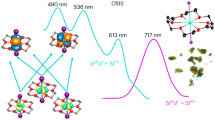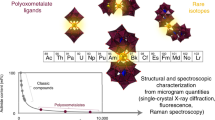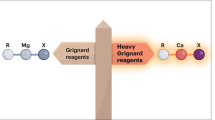Abstract
Californium (Cf) is currently the heaviest element accessible above microgram quantities. Cf isotopes impose severe experimental challenges due to their scarcity and radiological hazards. Consequently, chemical secrets ranging from the accessibility of 5f/6d valence orbitals to engage in bonding, the role of spin–orbit coupling in electronic structure, and reactivity patterns compared to other f elements, remain locked. Organometallic molecules were foundational in elucidating periodicity and bonding trends across the periodic table1,2,3, with a twenty-first-century renaissance of organometallic thorium (Th) through plutonium (Pu) chemistry4,5,6,7,8,9,10,11,12, and to a smaller extent americium (Am)13, transforming chemical understanding. Yet, analogous curium (Cm) to Cf chemistry has lain dormant since the 1970s. Here, we revive air-/moisture-sensitive Cf chemistry through the synthesis and characterization of [Cf(C5Me4H)2Cl2K(OEt2)]n from two milligrams of 249Cf. This bent metallocene motif, not previously structurally authenticated beyond uranium (U)14,15, contains the first crystallographically characterized Cf–C bond. Analysis suggests the Cf–C bond is largely ionic with a small covalent contribution. Lowered Cf 5f orbital energy versus dysprosium (Dy) 4f in the colourless, isoelectronic and isostructural [Dy(C5Me4H)2Cl2K(OEt2)]n results in an orange Cf compound, contrasting with the light-green colour typically associated with Cf compounds16,17,18,19,20,21,22.
This is a preview of subscription content, access via your institution
Access options
Access Nature and 54 other Nature Portfolio journals
Get Nature+, our best-value online-access subscription
$29.99 / 30 days
cancel any time
Subscribe to this journal
Receive 51 print issues and online access
$199.00 per year
only $3.90 per issue
Buy this article
- Purchase on Springer Link
- Instant access to full article PDF
Prices may be subject to local taxes which are calculated during checkout



Similar content being viewed by others
Data availability
The data that support the findings of this study are available within the paper and its Supplementary Information files. Cambridge Crystallographic Data Centre (CCDC) deposition numbers are 2025245 (1-241Am), 2058952 (1-Ho), 2025247 (2-Cf), 2025249 (2-Gdα), 2092534 (2-Gdβ), 2025248 (2-Dy), 2063323 (3) and 2025250 (4). These data can be obtained free of charge from the CCDC via www.ccdc.cam.ac.uk/data_request/cif.
References
Mingos, M. & Crabtree, R. Comprehensive Organometallic Chemistry III (Elsevier, 2007).
Zalkin, A. & Raymond, K. N. Structure of di-π-cyclooctatetraeneuranium (uranocene). J. Am. Chem. Soc. 91, 5667–5668 (1969).
Kealy, T. J. & Pauson, P. L. A new type of organo-iron compound. Nature 168, 1039–1040 (1951).
Hartline, D. R. & Meyer, K. From chemical curiosities and trophy molecules to uranium-based catalysis: developments for uranium catalysis as a new facet in molecular uranium chemistry. JACS Au 1, 698–709 (2021).
Pagano, J. K. et al. Actinide 2-metallabiphenylenes that satisfy Hückel’s rule. Nature 578, 563–567, (2020).
Apostolidis, C., Dutkiewicz, M. S., Kovács, A. & Walter, O. Solid-state structure of tris-cyclopentadienide uranium(III) and plutonium(III). Chem. Eur. J. 24, 2841–2844 (2018).
Windorff, C. J. et al. Identification of the formal +2 oxidation state of plutonium: synthesis and characterization of {PuII[C5H3(SiMe3)2]3}−. J. Am. Chem. Soc. 139, 3970–3973 (2017).
Formanuik, A. et al. Actinide covalency measured by pulsed electron paramagnetic resonance spectroscopy. Nat. Chem. 9, 578–583 (2017).
Dutkiewicz, M. S., Apostolidis, C., Walter, O. & Arnold, P. L. Reduction chemistry of neptunium cyclopentadienide complexes: from structure to understanding. Chem. Sci. 8, 2553–2561 (2017).
Apostolidis, C. et al. A structurally characterized organometallic plutonium(IV) complex. Angew. Chem. Int. Ed. 56, 5066–5070 (2017).
Dutkiewicz, M. S. et al. Organometallic neptunium(III) complexes. Nat. Chem. 8, 797–802 (2016).
Liddle, S. T. The renaissance of non-aqueous uranium chemistry. Angew. Chem. Int. Ed. 54, 8604–8641 (2015).
Goodwin, C. A. P. et al. [Am(C5Me4H)3]: an organometallic americium complex. Angew. Chem. Int. Ed. 58, 11695–11699 (2019).
Sonnenberger, D. C. & Gaudiello, J. Synthesis and cyclic voltammetric study of bis(pentamethylcyclopentadienyl)neptunium dichloride. J. Less-Common Met. 126, 411–414 (1986).
Laubereau, P. G. The formation of dicyclopentadienylberkeliumchloride. Inorg. Nucl. Chem. Lett. 6, 611–616 (1970).
Cary, S. K. et al. A series of dithiocarbamates for americium, curium, and californium. Dalton Trans. 47, 14452–14461 (2018).
Polinski, M. J. et al. Unusual structure, bonding and properties in a californium borate. Nat. Chem. 6, 387–392 (2014).
Sykora, R. E., Assefa, Z., Haire, R. G. & Albrecht-Schmitt, T. E. First structural determination of a trivalent californium compound with oxygen coordination. Inorg. Chem. 45, 475–477 (2006).
Carnall, W. T. A systematic analysis of the spectra of trivalent actinide chlorides in D3h site symmetry. J. Chem. Phys. 96, 8713–8726 (1992).
Carnall, W. T., Fried, S. & Wagner, F. Absorption spectrum of CfCl3. J. Chem. Phys. 58, 1938–1949 (1973).
Burns, J. H., Peterson, J. R. & Baybarz, R. D. Hexagonal and orthorhombic crystal structures of californium trichloride. J. Inorg. Nucl. Chem. 35, 1171–1177 (1973).
Laubereau, P. G. & Burns, J. H. Microchemical preparation of tricyclopentadienyl compounds of berkelium, californium, and some lanthanide elements. Inorg. Chem. 9, 1091–1095 (1970).
Streitwieser, A. & Müller-Westerhoff, U. Bis(cyclooctatetraenyl)uranium (uranocene). A new class of sandwich complexes that utilize atomic f orbitals. J. Am. Chem. Soc. 90, 7364–7364 (1968).
Minasian, S. G. et al. New evidence for 5f covalency in actinocenes determined from carbon K-edge XAS and electronic structure theory. Chem. Sci. 5, 351–359 (2014).
Evans, W. J. Tutorial on the role of cyclopentadienyl ligands in the discovery of molecular complexes of the rare-earth and actinide metals in new oxidation states. Organometallics 35, 3088–3100 (2016).
Hayton, T. W. Recent developments in actinide-ligand multiple bonding. Chem. Commun. 49, 2956–2973 (2013).
Jones, M. B. & Gaunt, A. J. Recent developments in synthesis and structural chemistry of nonaqueous actinide complexes. Chem. Rev. 113, 1137–1198 (2013).
Baumgärtner, F., Fischer, E. O., Kanellakopulos, B. & Laubereau, P. Tri(cyclopentadienyl)americium(III). Angew. Chem. Int. Ed. 5, 134–135 (1966).
Laubereau, P. G. & Burns, J. H. Tricyclopentadienyl-curium. Inorg. Nucl. Chem. Lett. 6, 59–63 (1970).
Kirker, I. & Kaltsoyannis, N. Does covalency really increase across the 5f series? A comparison of molecular orbital, natural population, spin and electron density analyses of AnCp3 (An = Th-Cm; Cp = η5-C5H5). Dalton Trans. 40, 124–131 (2011).
Strittmatter, R. J. & Bursten, B. E. Bonding in tris(η5-cyclopentadienyl) actinide complexes. 5. A comparison of the bonding in neptunium, plutonium, and transplutonium compounds with that in lanthanide compounds and a transition-metal analog. J. Am. Chem. Soc. 113, 552–559 (1991).
Kozimor, S. A. et al. Trends in covalency for d- and f-element metallocene dichlorides identified using chlorine K-edge X-ray absorption spectroscopy and time-dependent density functional theory. J. Am. Chem. Soc. 131, 12125–12136 (2009).
Arney, D. S. J. & Burns, C. J. Synthesis and properties of high-valent organouranium complexes containing terminal organoimido and oxo functional groups. A new class of organo-f-element complexes. J. Am. Chem. Soc. 117, 9448–9460 (1995).
Apostolidis, C. et al. [An(H2O)9](CF3SO3)3 (An=U-Cm, Cf): exploring their stability, structural chemistry, and magnetic behavior by experiment and theory. Angew. Chem. Int. Ed. 49, 6343–6347 (2010).
Polinski, M. J. et al. Chirality and polarity in the f‐block borates M4[B16O26(OH)4(H2O)3Cl4] (M=Sm, Eu, Gd, Pu, Am, Cm, and Cf). Chem. Eur. J. 20, 9892–9896 (2014).
Cary, S. K. et al. Emergence of californium as the second transitional element in the actinide series. Nat. Commun. 6, 6827 (2015).
Galley, S. S. et al. Synthesis and characterization of tris-chelate complexes for understanding f-orbital bonding in later actinides. J. Am. Chem. Soc. 141, 2356–2366 (2019).
Shannon, R. D. Revised effective ionic radii and systematic studies of interatomic distances in halides and chalcogenides. Acta Crystallogr. A 32, 751–767 (1976).
Schumann, H., Glanz, M., Hemling, H. & Ekkehard Hahn, F. Metallorganische Verbindungen der Lanthanoide. 93 [1]. Tetramethylcyclopentadienyl-Komplexe ausgewählter 4f-Elemente. Z. Anorg. Allg. Chem. 621, 341–345 (1995).
Jenkins, T. F. et al. Tetramethylcyclopentadienyl ligands allow isolation of Ln(II) ions across the lanthanide series in [K(2.2.2-cryptand)][(C5Me4H)3Ln] complexes. Organometallics 37, 3863–3873 (2018).
Acknowledgements
We thank I. May at Los Alamos National Laboratory (LANL) and G. P. Horne at Idaho National Laboratory for discussions. We acknowledge the US Department of Energy (DOE), Office of Science (SC), Basic Energy Sciences (BES) Heavy Element Chemistry Program (HEC) at LANL (E.R.B., A.J.G., S.A.K., Z.R.J., B.L.S., F.D.W., P.Y., J.S.; DE-AC52-06NA25396), at Florida State University (T.E.A.-S., A.N.G., J.M.S., C.J.W.; DE-FG02-13ER16414), and at the University of California at Irvine (W.J.E., T.F.J., J.C.W.; DE-SC0004739). C.A.P.G. was sponsored by a Distinguished J. R. Oppenheimer Postdoctoral Fellowship (LANL-LDRD, 20180703PRD1). We thank LANL-LDRD (L.M.S., A.J.G.; 20190091ER) for aspects of the 241Am experimental work. Theoretical research was performed using EMSL (grid.436923.9), a DOE-SC User Facility sponsored by the Office of Biological and Environmental Research. J.S. also thanks the National Natural Science Foundation of China (22076130), and the Fundamental Research Funds for the Central Universities (20826041D4117) and start-up funds from Sichuan University. J.N.C. and J.D.A. acknowledge the DOE-SC, Isotope Development and Production for Research and Application subprogram within the Office of Nuclear Physics for 241Am sample conditioning and dispensing. J.D.A. thanks the NNSA Plutonium Sustainment Program and the National Nuclear Security Administration (NNSA) Material Recycle and Recovery for funding. We thank E. R. Birnbaum and B. L. Ortiz for procurement of 241Am through the National Isotope Development Center, purchased with LANL DOE-SC-BES-HEC funds.
Author information
Authors and Affiliations
Contributions
E.R.B., W.J.E., A.J.G., S.A.K. and P.Y. devised the project and are corresponding authors. C.A.P.G. led lanthanide synthetic protocol development and performed Cf and Am synthetic work and characterization with oversight and help from A.J.G., along with expertise and support from L.M.S. and F.D.W. (UV–vis–NIR), M.T.J. (nuclear magnetic resonance (NMR) spectroscopy), T.F.J. (ligand preparation), B.L.S. (single-crystal XRD) and S.F.B. (radiological safety). S.A.K., N.H.A. and Z.R.J. prepared the LANL 249Cf stock solution; A.N.G., J.M.S. and C.J.W. prepared the FSU 249Cf stock solution; L.M.S., A.J.G., M.R.J. and J.N.C. prepared and characterized the 241Am stock at LANL. J.C.W. provided supporting characterization of lanthanide compounds. J.S., E.R.B. and P.Y. performed and analysed all theoretical work. Principal manuscript writing was by C.A.P.G., J.S., A.J.G., S.A.K., W.J.E., E.R.B. and P.Y., with input and editing from all authors. A.J.G. was the submitting author.
Corresponding authors
Ethics declarations
Competing interests
The authors declare no competing interests.
Additional information
Peer review information Nature thanks Weiqun Shi and the other, anonymous, reviewer(s) for their contribution to the peer review of this work. Peer reviewer reports are available.
Publisher’s note Springer Nature remains neutral with regard to jurisdictional claims in published maps and institutional affiliations.
Extended data figures and tables
Extended Data Fig. 1 Outline of the complexes synthesized in this work.
a, The known 1-M (M = Sm, Gd) complexes were chosen for their ionic radii similarities to Cf3+ (Sm, 0.958 Å; Gd, 0.938 Å; Cf, 0.95 Å). Complex 1-241Am was synthesized following prior methodology for 1-243Am to assess radiolytic effects. b, Complex 1-Dy was synthesized as Dy3+ (4f9) is valence isoelectronic to Cf3+ (5f9), and 1-Ho was synthesized as the ionic radius of Ho3+ (0.901 Å) is significantly smaller than that of Cf3+. c, Complexes 2-M (M = Gd, Dy) were synthesized as comparisons to 2-Cf and chosen for the metal having a similar ionic radius to Cf3+ (Gd) or for being valence isoelectronic (Dy). d, Eu3+ (0.947 Å) is a better ionic radius match to Cf3+ than Sm or Gd; however, we were unable to isolate 1-Eu using salt-metathesis protocols which instead led to reduction to a Eu2+ complex, 3.
Extended Data Fig. 2 Geometric features of the ‘{Cf(Cptet)2Cl2}1−’ anions and polymeric chain propagation.
a, View from the top of the metallocene fragment for Cf(1) showing the trans disposition of the Cptet C–H groups and the Cl–Cf–Cl bond angle. b, View from the top of the metallocene fragment for Cf(2) showing the cis disposition of the Cptet C–H groups and the Cl–Cf–Cl bond angle. c, d, View down the crystallographic c axis, showing that the Cf(1) and Cf(2) chains propagate parallel to the a axis—note that the arrangement of the panels is not indicative of their relative spatial arrangement.
Extended Data Fig. 3 Example bonding orbitals from 2-Cf and 2-Dy.
The lowest occupied valence f orbitals of a″ symmetry of 2-Cf (left, 27a″) and 2-Dy (right, 22a″) (contour value of 0.03 a.u.; see Supplementary Table 19). This shows the greater mixing between metal 5f and C 2p orbitals in 2-Cf compared to 4f and C 2p orbitals in 2-Dy.
Supplementary information
Supplementary Information
This file includes extensive experimental details on compounds synthesized in this work, photographs of select reactions and products, crystallographic data collection descriptions and comments on radiation-induced changes in crystals of 2-Cf, visual representations of molecular structures, nuclear magnetic resonance, UV–vis–NIR, FT-IR spectra, and full computational details.
Supplementary Data
Crystallographic information files for compounds 1-241Am, [241Am(Cptet)3]; 1-Ho, [Ho(Cptet)3]; 2-Cf, [Cf(Cptet)2Cl2K(OEt2)]n; 2-Gdα, α-[Gd(Cptet)2Cl2K(OEt2)]n; 2-Gdβ, β-[Gd(Cptet)2Cl2K(OEt2)]n; 2-Dy, [Dy(Cptet)2Cl2K(OEt2)]n; 3, [Eu(Cptet)2(THF)2]; and 4, [K(Et2O)(Cptet)]n.
Rights and permissions
About this article
Cite this article
Goodwin, C.A.P., Su, J., Stevens, L.M. et al. Isolation and characterization of a californium metallocene. Nature 599, 421–424 (2021). https://doi.org/10.1038/s41586-021-04027-8
Received:
Accepted:
Published:
Issue Date:
DOI: https://doi.org/10.1038/s41586-021-04027-8
This article is cited by
Comments
By submitting a comment you agree to abide by our Terms and Community Guidelines. If you find something abusive or that does not comply with our terms or guidelines please flag it as inappropriate.



